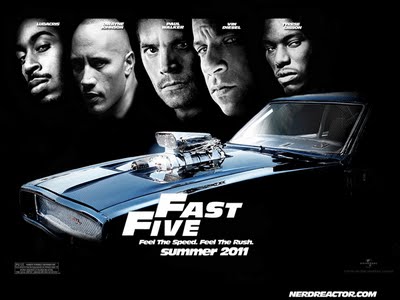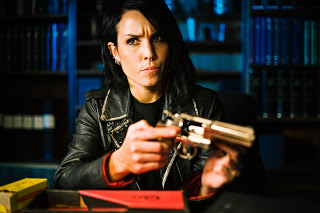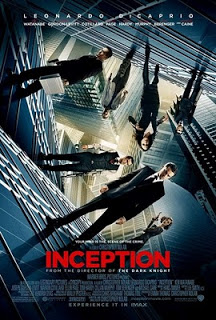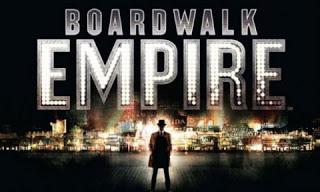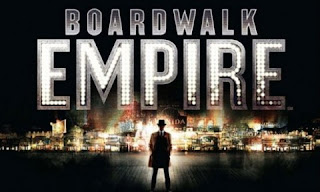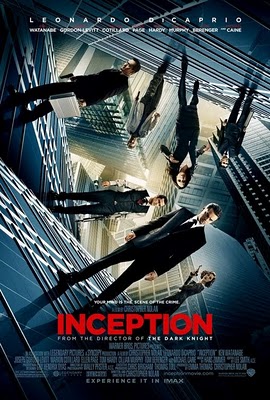Tag: Crime
Guest Writer Wednesday: The Girl Who Kicked the Hornet’s Nest
 |
|
| Enemy of the State: Heroine Lisbeth Salander Fights Back in The Girl Who Kicked The Hornet’s Nest |
This is a cross post from Opinioness of the World.
 |
| Michael Nyqvist stars as Mikael Blomkvist |
 In the U.S., the first book entitled The Girl with the Dragon Tattoo
In the U.S., the first book entitled The Girl with the Dragon Tattoo
 |
| Annika Gianini (played by Annika Hallin) with Lisbeth Salandar (Noomi Rapace) |
She does not complain and she doesn’t accept being a victim. Almost everybody has treated her so badly and has done horrible things to her but she doesn’t accept it and won’t become the victim they have tried to force her to be. She wants to live and will never give up. I find that so liberating. Her battle is for a better life and to be free and I think everybody experiences that at some point in their life. They say OK, I’m not going to take this anymore. This is the point of no return. I’m going to stand up and say no. I’m going to be true to myself and even if you don’t like me that’s fine. I don’t want to play the game of the charming nice sexy girl anymore, I’m me. I think everybody can relate to that.
Megan Kearns is a blogger, freelance writer and activist. A feminist vegan, Megan blogs at The Opinioness of the World. She earned her B.A. in Anthropology and Sociology and a Graduate Certificate in Women and Politics and Public Policy. She lives in Boston. She has previously contributed reviews of The Kids Are All Right, The Girl with the Dragon Tattoo, and The Girl Who Played with Fire to Bitch Flicks.
Guest Writer Wednesday: The Girl Who Played with Fire
 |
|
| Good Girl Gone Bad: Noomi Rapace as Lisbeth Salander Burns Up the Screen in The Girl Who Played with Fire |
Guest Writer Wednesday: The Girl with the Dragon Tattoo
 |
| Rebel with a Cause: A Feminist Heroine Emerges in film The Girl with the Dragon Tattoo |
This is a cross post from Opinioness of the World.
The story revolves around the disappearance of Harriet Vanger, the niece of a wealthy business tycoon, who vanished without a trace 40 years earlier. Harriet’s uncle has been tortured by her absence all these years. Journalist Mikael Blomkvist, who’s been convicted of libel, and Lisbeth Salander, an introverted punk who’s a brilliant researcher and hacker, seek to solve the baffling mystery. The book is a riveting twisting thriller with numerous suspects.
Blomkvist is an interesting character. A charming and passionate journalist championing for the truth, he vacillates between cynicism and naïveté. Dejected after his conviction, he yearns to clear his name. He also frequently bed hops yet has enormous respect for women, often befriending them. While acclaimed Swedish actor Michael Nyqvist gives a valiant effort, he does not imbue the character with enough charisma.
But the sole reason to go see the movie (and read the book too) is for Lisbeth Salander. Noomi Rapace, who won a Guldbagge Award (the Swedish Oscars) for her portrayal, plays her perfectly. She stepped into the role by training for 7 months through Thai boxing and kickboxing (in the books Lisbeth boxes too) as well as piercing her eyebrow and nose, emulating Lisbeth’s punk look. A nuanced performance, Rapace plays the tattooed warrior with the right blend of sullen introvert, keen intellect and fierce survivor instincts. Salander is a ferocious feminist, crusading for women’s empowerment. Facing a tortured and troubled past, Salander is resourceful and resilient, avenging injustices following her own moral compass. An adept actor, Rapace conveys emotions through her eyes, never needing to utter a word. Yet she can also invoke Salander’s visceral rage when warranted.

Also, if you’re like me and reading each book before you see the film and you haven’t read the second book yet, be prepared for spoilers as there are scenes NOT in the first book that are taken from the second book and integrated into the film, such as Lisbeth’s flashbacks and the topic of her conversation with her mother.
 In the book, Larsson makes social commentaries on fiscal corporate corruption, ethics in journalism, and the role of upbringing on criminal behavior. Larsson also provides an interesting commentary on gender roles with his two protagonists. Despite Blomkvist’s social nature and Salander’s private behavior, they both stubbornly follow their own moral code. Both also possess overt sexualities. Yet society views Blomkvist as socially acceptable and perceives Salander as an outcast. These themes are absent from the movie adaptation.
In the book, Larsson makes social commentaries on fiscal corporate corruption, ethics in journalism, and the role of upbringing on criminal behavior. Larsson also provides an interesting commentary on gender roles with his two protagonists. Despite Blomkvist’s social nature and Salander’s private behavior, they both stubbornly follow their own moral code. Both also possess overt sexualities. Yet society views Blomkvist as socially acceptable and perceives Salander as an outcast. These themes are absent from the movie adaptation.
The Girl with the Dragon Tattoo has received an exorbitant amount of attention for Larsson’s controversial central theme of violence against women. It’s true that both the book and film portray graphic violence. The movie does not shy away from the uncomfortable subject matter. In the book, women fall prey to being assaulted, murdered, and violently raped. A pivotal rape scene disturbs and haunts the viewer. But sexual assault is a reality women face, albeit an ugly truth that we as a society may not want to see. Yet Larsson in the book and Oplev in the film never made me feel as if women were victimized. On the contrary, women, particularly in the form of Salander, are powerful survivors. She fights back, not merely accepting her circumstances.
As Melissa Silverstein of Women & Hollywood wrote in Forbes,
As my friend playwright Theresa Rebeck says, “The world looks at women who fight back as crazy.” We constantly see movies, TV shows and plays where men commit violence against women. That’s our norm. Here we have a woman who is saying no more and exacts revenge. Larsson is very clearly saying what we all know and believe. Lisbeth is not crazy. She is a feminist hero of our time.
Violence against women is a pervasive issue. According to the anti-sexual assault organization RAINN, “every 2 minutes in the U.S., someone is sexually assaulted; nearly half of these victims are under the age of 18, and 80 percent are under 30.” And in Sweden, the problem is just as pervasive. Larsson states that “46 percent of the women in Sweden have been subjected to violence by a man.” We must not continue to brush these crimes aside. The original Swedish title of The Girl with the Dragon Tattoo (both the book and the film) is Män Som Hatar Kvinnor, which translates to “Men Who Hate Women.” I’m glad that Larsson devoted his books to shedding light on misogyny in society.
A provocative and haunting film, The Girl with the Dragon Tattoo is worthy of watching for Rapace’s subtle yet powerful performance. It’s rare for an audience to see a strong, self-sufficient woman on-screen. It’s even more unusual for a movie to address the stigma of sexual assault as well as the complexity of gender roles. Watch the movie and read the book. Get acquainted with Lisbeth Salander; she may be the most exhilarating, unconventional and surprising character you will ever encounter.
Best Picture Nominee Review Series: Inception
SPOILER ALERT
Other interesting takes on Inception:
Guest Writer Wednesday: Boardwalk Empire
Ripley’s Pick: The No. 1 Ladies’ Detective Agency
 |
| The No. 1 Ladies’ Detective Agency |
Movie Review: Inception
 |
The plot of Inception is deceptively simple: a tale of corporate espionage sidetracked by a man’s obsession with his dead wife and complicated by groovy special effects and dream technology. As far as summer blockbusters and action/heist/corporate espionage movies go, it’s not bad. Once you get beyond the genuinely beautiful camera work and dizzying special effects, however, you’re not left with much.
One thing that really bothers me about the film–aside from its dull, lifeless, stereotypical, and utterly useless female characters (which I’ll get to in a moment)–is that nothing is at stake. Dom Cobb (Leo DiCaprio) and his team take on a big new job: one seemingly powerful businessman, Saito (Ken Watanabe), wants an idea planted into the mind of another powerful businessman, Robert Fischer (Cillian Murphy). Specifically, Saito wants Fischer to believe that dear old dad’s dying wish was for him to break up the family business, so that, we assume, Saito wins the game of capitalism. Should the team go through with the profitable job? We aren’t supposed to care about the answer to this question or what is at stake in the plot.
It’s assumed that, of course we want Cobb to win because he’s really Leo, and, you see, Leo is talented but Troubled. What troubles him? You guessed it: a woman. A woman whose very name–Mal (played by Marion Cotillard, an immensely talented actress who’s wasted in this role)–literally means “bad.” Who or what will rescue Cobb/Leo from his troubles? You guessed it again: a woman. This time, it’s a woman whose very name–Ariadne (played by Ellen Page in a way that demands absolutely no commentary)–means “utterly pure,” and who is younger, asexual (a counter to Mal’s dangerous French sexuality) and without any backstory or past of her own to smudge the movie’s–and her own–focus on Cobb/Leo. So, it’s not a stretch here to say that Cobb needs a pure woman to escape the bad one. Virgin/whore stereotype, anyone?
SPOILER ALERT
So, what makes Mal so bad? In life, she was his faithful wife (for all we know) and mother of his two children. In the film, she’s not even a real woman, but a figment of Cobb’s imagination, haunting him with her suicide. (Note: For a better version of this story, see Tarkovsky’s Solaris, or the crappy Soderbergh adaptation starring George Clooney.) Her constant appearances threaten Cobb’s inception task, and while we can imagine a suicide haunting this hard-working man, we learn the much uglier truth later: while developing his theory of “inception,” Cobb used Mal as his first test subject–planting the idea in her mind that reality was not what she believed it to be. Now we have a main character who exacted extreme emotional violence on his wife, driving her kill herself–yet she’s the evil one.
What makes Ariadne so pure? It’s simple, really. We know she was a brilliant student of architecture, and…and…and…that’s it. The film needed an architectural dream space that wouldn’t be marred by trauma, or memory, or the like, so the natural choice would be for a computer program to design it, right? But a computer program couldn’t also counsel Cobb through the trauma of his wife’s suicide and, ultimately, coach him through killing her apparition. She is invested in getting through the job, as her life depends on it, but why does she give a damn about Cobb? Because she’s a woman architect, and women are nurturing creatures, right? So, we have a main character who exacted extreme emotional violence on his wife and threatens to kill his entire team through self-sabotage over guilt, but luckily he has one good woman to pull him through.
Is it possible to look differently at these two characters? Even if you read the movie as an allegory of filmmaking/storytelling, we’re still left with women who are sidekicks, and who serve merely as plot devices. Maria of The Hathor Legacy writes
Both Mal and Ariadne are symbols, not real characters, and I think this is reflected in the kinds of lines and characterization each is offered. In a movie where businessmen are dryly humorous, several million dollars are devoted to a man’s daddy-issues, and Dom’s nostalgic love for family is symbolized through a honey-heavy shot of golden light haloing his young moppets’ heads, the wooden-ness and flatness of the lines offered these characters is startlingly noticeable.
In other words, even if you refute the realism of the film and its characters, you’re still left with some major gender trouble. Is Cobb a sympathetic character? No. Do we want his big inception job to work? Don’t care. What I care about, for the purposes of this review, is that we have–yet again–a successful mainstream movie that relies on tired tropes of female characters.
Other interesting takes on Inception:
- Inception Regrets Nothing on Feminist Music Geek
- Five Non-Spoiler-y Things About Inception on the Bitch Magazine website
- Inception: A Feminist Review on Clarissa’s Blog
Flick-Off: Taken

imdb summary: Seventeen year-old Kim is the pride and joy of her father Bryan Mills. Bryan is a retired agent who left the Secret Service to be near Kim in California. Kim lives with her mother Lenore and her wealthy stepfather Stuart. Kim manages to convince her reluctant father to allow her to travel to Paris with her friend Amanda. When the girls arrive in Paris they share a cab with a stranger named Peter, and Amanda lets it slip that they are alone in Paris. Using this information an Albanese gang of human traffickers kidnaps the girls. Kim barely has time to call her father and give him information. Her father gets to speak briefly to one of the kidnappers and he promises to kill the kidnappers if they do not let his daughter go free. The kidnapper wishes him “good luck,” so Bryan Mills travels to Paris to search for his daughter and her friend.
First, the tortured relationship between Kim and her father exists solely to set up the mother as a careless, libera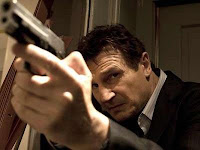 l, money-grubbing asshole. While he gets to be the oh-it’s-too-dangerous-for-my-17-year-old-daughter-to-go-to-Paris-alone “good parent,” the mother gets relegated to the role of oh-just-let-her-go-I-mean-what-could-possibly-go-wrong “bad parent.” Of course, shit goes terribly wrong, and the audience can’t help but be all, “that horrible mother should’ve known better!” Then, as is usually the case, Daddy gets to rush to the rescue while Mommy stays at home sobbing into the arms of her new, rich, conveniently helpless husband.
l, money-grubbing asshole. While he gets to be the oh-it’s-too-dangerous-for-my-17-year-old-daughter-to-go-to-Paris-alone “good parent,” the mother gets relegated to the role of oh-just-let-her-go-I-mean-what-could-possibly-go-wrong “bad parent.” Of course, shit goes terribly wrong, and the audience can’t help but be all, “that horrible mother should’ve known better!” Then, as is usually the case, Daddy gets to rush to the rescue while Mommy stays at home sobbing into the arms of her new, rich, conveniently helpless husband.
To make matters worse, the Albanese gang deals in sex trafficking, which is an actual, serious issue in the world, an issue that this film exploits to serve the ultimate, final plot point: Daddy gets to save Kim from the evil Albanese sex traffickers in the moments just before she loses her virginity and remains forever “impure.” The most offensive aspect of all this rests on the fact that Bryan’s (and the film’s) focus never veers from his daughter. So, while we see countless drugged-up young women tied to bed posts, waiting to be raped again, the film treats them and their situation as entirely insignificant; the focus always remains on Daddy’s ass-kicking, murdering attempts to save his daughter’s virginity.
After he finds her friend Amanda dead and tied to a bedpost, he moves on to the next young woman who might help him, a girl who happens to have his daughter’s jacket.  He runs from room to room, finding women unconscious, enslaved, raped repeatedly, and he saves that particular girl, not because he’s appalled by what’s happened to her, but because she might lead him to his daughter. He nurses her back to health, and as soon as she can speak full sentences, he interrogates her about where she got the jacket. Basically, the film makes absolutely no attempt whatsoever to comment on the atrocity of sex trafficking—it serves only as a plot device to help Bryan redeem his broken relationship with his virginal daughter.
He runs from room to room, finding women unconscious, enslaved, raped repeatedly, and he saves that particular girl, not because he’s appalled by what’s happened to her, but because she might lead him to his daughter. He nurses her back to health, and as soon as she can speak full sentences, he interrogates her about where she got the jacket. Basically, the film makes absolutely no attempt whatsoever to comment on the atrocity of sex trafficking—it serves only as a plot device to help Bryan redeem his broken relationship with his virginal daughter.
Movie Review: Duplicity
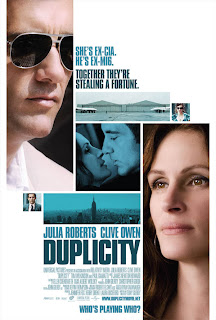 Duplicity (2009). Written and directed by Tony Gilroy. Starring Julia Roberts and Clive Owen. Excellent supporting roles by Tom Wilkinson and Paul Giamatti.
Duplicity (2009). Written and directed by Tony Gilroy. Starring Julia Roberts and Clive Owen. Excellent supporting roles by Tom Wilkinson and Paul Giamatti.
I saw Duplicity in the theaters last month in part because of the positive reviews paired with skeptical press and questions about whether Julia Roberts could still open a movie.  (Questions that angered me enough to express my opinion with my wallet, an action I believe is important.) A recent story clip on MSN compelled me to revisit the movie. The headline “Moneymakers” beside a picture of Julia Roberts, with the byline “Hollywood’s most bankable actresses” links to an article that discusses which actresses can currently be counted on to bring in the bucks. “Moneymaker”, of course, is a term most commonly associated with pornography, prostitution, and the objectification of the female ass, in particular.
(Questions that angered me enough to express my opinion with my wallet, an action I believe is important.) A recent story clip on MSN compelled me to revisit the movie. The headline “Moneymakers” beside a picture of Julia Roberts, with the byline “Hollywood’s most bankable actresses” links to an article that discusses which actresses can currently be counted on to bring in the bucks. “Moneymaker”, of course, is a term most commonly associated with pornography, prostitution, and the objectification of the female ass, in particular.
The actress-as-commodity isn’t anything unusual in the sexist institution of mainstream filmmaking, but describing a popular actress as a “moneymaker” creates a serious problem. While box office numbers (and particularly opening weekend numbers) determine a film’s success and influence executives in terms of which movies are greenlighted, I have to wonder if it’s the actress’ ass alone bringing people into theaters.
Anyhow, on to the movie.
Duplicity expects level of sophistication and intelligence from its audience, which includes the ability to follow a story that jerks viewers from location to location, and from time to time. It’s a romantic comedy, but it makes you think. Maybe this is a problem for box-office bucks, but a little mental effort makes a movie much more enjoyable–for adults, at least.
Thinking about Ripley’s Rule as a litmus test, this movie actually barely passes–if at all. This fact ordinarily is a big problem for me, but in Duplicity it feels like an afterthought. It’s a romantic comedy, but not the kind we’ve become accustomed to.  As a number of reviewers have previously mentioned, this film hearkens back to the screwball comedies of the 1940s, when wit was king, and the women generally matched the men in smarts (that’s not to say that the gender politics were a mess in those movies). What makes the movie good–and so different from other romantic comedies–is that the man and woman are on an even keel. Domination of one or the other sex isn’t the issue. These characters have bigger fish to fry–namely, their bosses in the world of corporate espionage. It’s as if Michael Clayton were remade into a romantic comedy.
As a number of reviewers have previously mentioned, this film hearkens back to the screwball comedies of the 1940s, when wit was king, and the women generally matched the men in smarts (that’s not to say that the gender politics were a mess in those movies). What makes the movie good–and so different from other romantic comedies–is that the man and woman are on an even keel. Domination of one or the other sex isn’t the issue. These characters have bigger fish to fry–namely, their bosses in the world of corporate espionage. It’s as if Michael Clayton were remade into a romantic comedy.
If you aren’t convinced that the movie is worth seeing, the opening credits present the strangest and most hilarious fight scene in recent memory.
Here’s the trailer:
Observe and Report Roundup
April is National Sexual Assault Awareness Month.
An odd coincidence is that Jody Hill’s Observe and Report is currently in theaters, and getting all kinds of attention for a rape scene that’s played as comedy. Worst of all, many out there are defending the movie as an edgy, dark comedy, and arguing that the scene doesn’t depict rape at all.
I’ve hesitated writing about the film; movies this noxious don’t deserve whatever free press a site like ours provides (assuming that all press is, in some way, good press). With no plans to ever see OaR, I don’t know that I could contribute a whole lot to the discussion personally, but thought I’d compile a list of what other smart people are saying, and give you a glimpse of the R-rated trailer–with hopes that it shows you as much of the movie as you’ll ever want to see.
A lot of the discussions center around the question of whether or not the sexual encounter shown in the final seconds of the trailer is actually rape. Stupid question; yes, it is. Period. The more interesting debate, which not many are taking up (according to my reading) is why a film like this is being made at this time. I’m all for dark comedy, though this doesn’t really seem like one (MaryAnn Johanson asks whether the movie is a comedy at all in her weekly column at AWFJ), and what worries me is the kind of cultural work being done. All those people who like to shout about how movies are just entertainment and say people like us have no sense of humor, or take things too seriously, are underestimating the power of representation–of the arts in general, film-making included. Although the movie has an R rating, we must ask who the intended audience of such a movie is. Clearly, it’s male, and the movie has a ring of adolescence about it (an epidemic of our time), with its “jokes” about sex, drug use, alcoholism, violence, and whatever else I’ll miss by refusing to see it, which clues us into the fact that it is for people who are still in a phase of their lives when they figure out their own values.
People are seeing OaR, too. It finished fourth in the holiday weekend box office, selling over $11 million worth of tickets. There’s a desire for this sort of thing, and the interesting question is: Why?
Here are some highlights (and lowlights) from the blogosphere:
- Friday Feminist Fuck You: Seth Rogen @ Feministing (This one has been getting lots of play, but if you haven’t seen it yet, please check it out.)
- Shorter Seth Rogen: Rape is Hilarious @ Feministe (Jill reminds us that the real trouble here is that the claim that the scene doesn’t depict a rape.)
- Observe and Report Date Rape Scene Sparks Outrage @ The Huffington Post (Be sure to vote in their poll about the scene–and prepare for the expected disappointment when you read the results. )
- Sexism Watch: Date Rape Gets Mainstream Film Release by Melissa Silverstein @ The Huffington Post (Silverstein also runs the awesome Women & Hollywood.)
- Is Date Rape Funny? Seth Rogen Explains it All for You by Margaret @ Jezebel (Quotes from interviews with Rogen and Anna Faris help you understand a little bit about the attitudes Hollywood rewards.)
- Observe & Report: On Real Rape and Um. by Sady @ Tiger Beatdown (Two well-articulated analyses on rape in this film and its impact on actual women.)
And some mainstream reviews:
- Observe and Report by Michael Phillips @ The Chicago Tribune (In a review that otherwise seems fair, writer Micheal Phillips seriously drops the ball–to say the least–when he claims: “The best, riskiest bit in Observe and Report involves Faris, with wee vomitous spillage drying on the pillow by her slack jaw, underneath Rogen, who cannot believe the dolt of his fondest desires is trashed enough to give him a toss.”)
- Mall Crisis? Call Security. Then Again, Maybe Not by Manhola Darghis for The New York Times (Darghis can be counted on as a female voice in the NYT, but she often–and this is no exception–offers more respect than is due.)
- Observe and Report by Peter Travers for Rolling Stone (The most appalling of all the “official” reviews I’ve read, which should be no great surprise, considering the source. Here’s a sample: “Props to Hill and Rogen for believing you can play anything for a hoot, including R-rated sex and violence.” Yeah–props. That’s what I was going to say.)
Other sickery:
- Writer Jody Hill describes his latest movie as “a dark, crazy, awesome journey” in “An Auteur of Awkward Strikes Again” in the NYT
- An apologist for the rape scene, in a column from New York Magazine, says:
But, given all the horrible things Ronnie does later in the movie — out of spite, or stupidity, or flat-out psychosis — this scene winds up seeming a lot less awful as the movie goes on. For one thing, as horribly misdirected as it becomes, his “courtship” of Brandi is the only thing in Ronnie’s life that comes partly from a place of sweetness rather than entirely from a place of darkness.
- And a special GFY to Bill Gibron of PopMatters, whose article “No Means Ho: Debating Observe and Report‘s Most Controversial Scene” is the worst I’ve seen, and includes gems such as:
Audiences are happy when Ronnie ends up with shy coffee girl Nell, someone who he’s built up a narrative-long relationship of openness and trust. When Brandi tries to get back in his good graces, Ronnie gives her a public kiss-off that centers on her sleeping around.
and, best of all
So which is it? Rape, or the reality of dating circa 2009? As with anything Hill has to say, the meaning is not clear. Feminists have the right to be angry, especially when a mainstream Hollywood movie offers such a backward vision of male/female fornication. But is Observe and Report really saying anything new? In this Girls Gone Wild dynamic of brazen openness and complete lack of shame, should a drunken slut bear any of the blame? It’s not a question of that horrid old excuse “she had it coming.” It’s more of a mirror on where society has sunk since women were empowered to ‘take back the night.’ Clearly, had Hill meant the scene to be something akin to pure sexual assault, Brandi would have been treated like a piece of dead meat.
